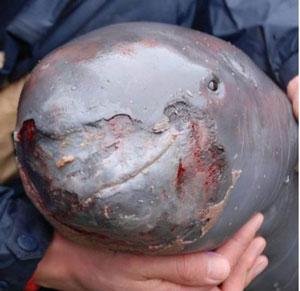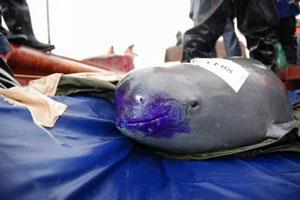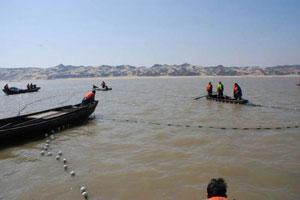In order to obtain the data of the natural population of Yangtze finless porpoises, researchers from Institute of Hydrobiology, Chinese Academy of Sciences (IHB)conducted a 10-day sampling survey on Yangtze finless porpoises in the water area of Duchang county, Poyang Lake.

IHB Researchers performed ultrasonic check-up for the captured Yangtze finless porpoises (Picture/IHB)
22 Yangtze finless porpoises were captured and four recaptured. Excluding the recaptured individuals, in total, 18 different individuals were captured and released.
The researchers took photos of the captured Yangtze finless porpoises. A series of examinations were later
performed on them: morphological measurements, ultrasonic check-up and blood sampling. All the captured Yangtze finless porpoises were labeled with PIT.

The snout region of the captured Yangtze finless porpoises seriously festered (Picture/IHB)
Most of the captured Yangtze finless porpoises were somewhat injured, especially in the snout and flipper region. It is presumed that their injuries were caused by the stake nets fixed in Poyang Lake in the dry season of 2009. In an attempt to catch prey fishes in the lake, the Yangtze finless porpoises finally got into the stake nets. They have struggled to free themselves by head-butting the nets. In the hard struggle, the nets lacerated the skin around their snout region which then was infected by bacteria. Researchers disinfected the injured Yangtze finless porpoises and injected antibiotics for the most seriously injured ones. They released all the captured Yangtze finless porpoises to the broad water areas.
Recent years, the dry season in Poyang Lake is longer than before. Drought frequently occurs. Fishery resources were seriously reduced due to this unfavorable condition. Fishermen now often resort to stake nets or electric fishing machines to capture fishes. This harmful fishing practice could lead to two results. One is that the fishery resources in Poyang Lake will be further declined. The other result is that direct injury will occur in the endangered aquatic organisms including Yangtze finless porpoises.
|
Researchers dressed the wound for the captured Yangtze finless porpoises (Picture/IHB) |
|
IHB Researchers captured Yangtze finless porpoises by acoustic fishing method. (Picture/IHB) |
It is estimated that in the dry season of 2009, tens of Yangtze finless porpoises were dead in Poyang Lake. IHB received several death reports of Yangtze finless porpoises and consecutively collected four specimens of Yangtze finless porpoises which died of injuries caused by the stake nets.
IHB researchers have already reported the survey results to Jiangxi Agriculture Bureau and Office of Aquatic Fauna and Flora Conservation of Ministry of Agriculture, appealing for some emergent measures to be taken to strengthen the management of fishery resources in Poyang Lake, implement the sustainable fishery pattern, promote the environmental quality of Poyang Lake and thus protect the endangered aquatic organisms.
Poyang Lake, located in Jiangxi province, is the largest freshwater lake in China. It boasts the most intensive and largest number of the natural population of Yangtze finless porpoises. There are about 450 Yangtze finless porpoises in the lake.
This survey was supported by Poyang Lake Fishery Administrative Bureau and Duchang Fishery Administrative Bureau in Jiangxi province. 33 fishermen from both Hubei and Jiangxi provinces took part in the survey. IHB researchers carried out the first investigation on the population of Yangtze finless porpoises along Poyang Lake in February 2009.
Related News
- EurekAlert!: Dark Age For China s Winged Dinosaurs Ends With Renaissance Of Long Lost Feather Coloring
- Superconducting Magnet Technology Center Established in Weifang
- RS-based Studies of Post-Earthquake Conditions in Wenchuan
- Exceptional Dinosaur Fossils Show Ontogenetic Development of Early Feathers







